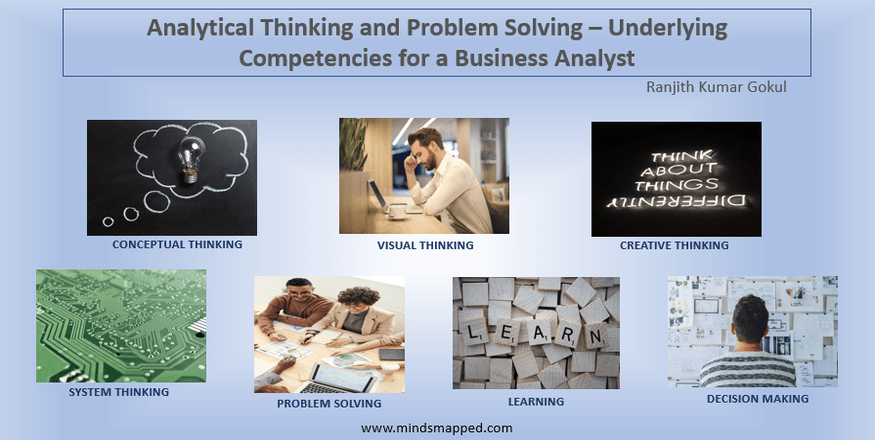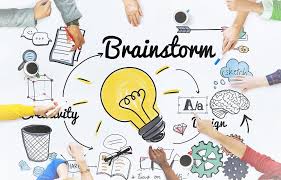
Analytical Thinking and Problem Solving – Underlying Competencies for a Business Analyst
Analytical Thinking and Problem Solving
Business Analysis Book of Knowledge (or BABOK as it is widely known) is a book authored and published by IIBA (International Institute of Business Analysis). BABOK serves as a guide for the Business Analysts across the world. It’s widely recognized and referred to when we need to understand the role of a Business Analyst better.
| Competency is defined as competence (in something) competence (in doing something) the ability to do something well Ex: to achieve a high level of competence in French professional/technical competence |
All the competencies mentioned in this section aren’t exclusive for the BA role. In fact, learning and exceling in these would open many more avenues for the BAs to explore. Accordingly, having an idea on how these work during our BA tasks will help us in appreciating their importance and identify the areas of improvement. In this article, we try to explore these underlying competencies, apply those to real-life scenarios in a Business Analyst’s work and grasp the inherent need of applying them in the right manner.
BABOK mentions six categories into which these competencies can be grouped:
- Analytical and Problem Solving
- Behavioral Characteristics
- Business Knowledge
- Communication Skills
- Interaction Skills
- Tools and Technology
Let’s delve deep into each of these categories to understand the skills that comprise them and know how they contribute to the work of a Business Analyst.
Analytical Thinking and Problem Solving
When a Business Analyst gets on boarded to a project, he/she spends the initial days trying to comprehend the high-level requirements provided (that is if a BRD is provided by the client. Else the first few discussions with the client would be focused on preparing and finalizing the BRD). This is then followed by analyzing the problem statement and identifying the probable solutions to it. This requires keen analysis of the problems and opportunities, understanding the changes that enable maximum value delivery and working together with the stakeholders to understand how it would impact the overall solution.
Information available for a Business Analyst can be in various formats like:
- User guides
- Spreadsheets
- Schematics
- Stakeholder concerns
- Customer feedback
Analytical thinking becomes necessary to find out which of these information sources would be relevant and to what extent. Also, it’s necessary to know what’s the right way to present the information and ideas. For example, in a project dealing with a user interface, it’s a good practice to include wireframes. Whereas, in a project dealing with data flows, using an activity diagram comes handy (provided the Business Users are comfortable with UML concepts). It is analytical thinking that enables a Business Analyst to take a call on how to represent the information to make it easy to understand and assimilate.
The core competencies that are part of Analytical Thinking and Problem Solving are:
- Creative Thinking
- Decision Making
- Learning
- Problem Solving
- Systems Thinking
- Conceptual Thinking
- Visual Thinking
Creative Thinking
Generating new ideas or approaches, and alternatives to problem solving and opportunities can be done by a Business Analyst only when creative thinking is applied. More often, business users, having spent considerable amount of their experience in conventional thinking in their field, may find it difficult to look at the issues with a different perspective. Whereas, Business Analyst, due to their lack of familiarity with the existing process and procedures, can question the assumptions and in turn find new ways to get the issues resolved. It may be a result of combining, changing and re-applying existing concepts or ideas. It could also be due to implementation of best practices from a different project which the Business Analyst was earlier part of. At times, it could be an amalgamation of processes from different domains-based projects being tested out in the current project. All in all, the novel approach that a Business Analyst can bring by deploying creative thinking can yield effective results.
Creative Thinking generally can include:
- Generating and productively considering new ideas
- Exploring concepts and ideas that are new
- Exploring changes to existing concepts and ideas
- Generating creativity for self and others and
- Applying new ideas to resolve existing problems
Decision Making
Gathering all the information needed to arrive at a decision, analyzing it, comparing the options available, defining the pros and cons of every option, and then finalizing the most optimum option – all these together determine what goes behind the decision making. Having said that, a Business Analyst never takes a decision when presented with alternatives. He makes a detailed study and helps the business users in taking the right decision. Facilitating and not decision-making is what a Business Analyst does. Persuasion skills can help in driving and encouraging the business users to prefer a certain option over other though.
Documenting the decision made along with the reasoning helps in cross-checking later and reduces the time taken in taking a similar decision at a future point of time or verifying the discussions that went behind the decision-making process.
Effective decision-making needs:
- Relevant stakeholders are represented in the decision-making process
- Every stakeholder understands the rationale behind the decision
- The pros and cons of every available and suitable option are clearly called out and discussed with the stakeholders
- All sorts of uncertainty are either eliminated or accepted while taking the decision
- The need or the opportunity is well-addressed by the decision taken
- Decision taken is in the best interest of all the stakeholders
- Stakeholders are well-aware of all the conditions, environment, and measures which led to the decision taken
- Finally, the decision is made
These steps ensure the decision-making process is clear, keeping all the effected parties well-informed and avoiding ambiguity in the decision taken.
Learning
Every project that a Business Analyst works on can bring a different learning with it. Right from the type of project, methodology used, type of issue being focused upon, domain, timelines to the functionalities involved, type of documentation used, processes followed; a lot of differences exist in each project. For a Business Analyst, these changes effect the most. Every project demands the Business Analyst to be quick on his feet to adapt and own up the new way of doing work. For example, in one project a Business Analyst may work on revamping an entire e-commerce website. In the very next project, he ma deal with an internal employee engagement portal. Yet another project could be to develop a mobile app for a retail giant. Though all of these UI/UX based projects, the underlying functionalities is as different as it can get.
To manage such wide variations in projects, learning becomes very crucial all the time to be able to contribute effectively in rapidly changing and evolving environments.
Learning involves:
- Gaining knowledge or skills
- Domain understanding through initial acquisition, learning of raw facts (through comprehension of their meaning)
- Applying the knowledge in day-to-day work
- Analysis
- Synthesis and
- Evaluation
Through learning in this way, when a Business Analyst completes the analysis, he will be able to synthesize the information and identify opportunities to create new solutions and evaluate the effectiveness of those solutions.
Learning technique used depends on the type of learning outcome. Learning technique can be:
- Visual: through presentation of pictures, diagrams, models, videos, photographs, videos
- Auditory: verbal language, written language, text
- Kinesthetic: learning by doing
We can determine the effectiveness of the learning based on:
- Being aware that learning is a process s for all stakeholders
- Concepts learnt are presented and the understanding demonstrated
- Ability to apply concepts to new areas or relationships is displayed
- New concepts, facts, ideas or opinions are rapidly absorbed
- The new points absorbed are effectively presented
Problem Solving
The business users do not always have a clarity on what is the exact problem that they are facing. For example, the client may say that the sales are reducing drastically since last 2 quarters at a specific store and he needs to solve this issue. While this is surely an issue, having no further information about the problem will not help. So, a Business Analyst must identify the root cause and then devise ways or process to counter the root cause in order to bring back the sales to the usual numbers. This is what problem solving involves.
Helping the stakeholders also to understand the root cause would help in faster problem solving.
Problem solving starts with identifying the problem that needs to be solved. Goals and objectives of all stakeholders should be well-articulated to understand the underlying conflicts if any. All the assumptions made should be called out. The objectives that are supposed to be met by solving the problem should be identified and concurred upon by the stakeholders. All options available should be weighed as per the pros and cons to identify the best solution.
The effectiveness of the problem-solving is determined by:
- Confidence of the participants in the process of problem-solving
- Shortlisted solutions solve the root cause of the problem and meet the objectives set
- How the problem-solving framework measures the new solution options and evaluates their effectiveness
- Avoiding decision-making based on unvalidated assumptions or pre-conceived notions
Systems Thinking
This involves understanding of how people, processes and technology interact within an organization. It helps the Business Analyst in developing view of the enterprise.
System consists of properties, behaviors and characteristics that emerge based on the interaction of the components of the system. Understanding the components in silos may not help. For example, to understand payments, it is not enough to know how the customer’s account is debited and by how much. We also need to know the payment gateway being used, the merchant account being active and sending notification of having received the payment, the merchant’s account displayed the exact amount credited and the total balance accurately. Any irregularities in the process can also be due to external factors.
The effective usage of systems thinking can be evaluated by:
- Communicating how a minor change in one of the components can affect the entire system
- Communicating how a change in the system can impact the environment
- Communicate how the system adapts to internal and/or external pressures
Conceptual Thinking
The information gathered to solve a problem statement can be from disparate sources and quite overwhelming. Proper conceptual thinking helps in skimming through such seemingly unrelated information and connecting the otherwise abstract information.
Trying to find the link between contexts, solutions, needs, stakeholders and changes by observing the patterns which may not seem obvious; understanding how the smaller pieces of data fit in the larger context by using past experiences, intuition, knowledge creativity and abstract thinking to define alternatives, options and ideas that are usually not easy to understand or related – all these come under conceptual thinking.
Effectual conceptual thinking can be measured by:
- Connecting disparate information and seeking to understand the relationship
- Confidence in understanding the concept which is to be communicated to the stakeholders.
- Using a combination of information and uncertainty to formulate abstract concepts
- Pulling out the learnings from previous projects and using it here to understand the current project better.
Visual Thinking
Whenever complex ideas are being discussed, it is advisable to rely on some visual representation to have everyone on the same page. This helps the Business Analyst too, in understanding the concepts better.
Visual Thinking is the ability to imagine and put a format for it in the form of visual concepts, graphics, models, diagrams, and constructs to convey and integrate non-visual information. It can also be used to bring clarity to visual based applications using wireframes. Visuals help in presenting the information easily to avoid misinterpretation and develop a common understanding. Through this, any variations in understanding among the stakeholders can be dealt with effectively. With enough clarity, it is simpler to achieve common agreement on the solution being designed.
Measuring the effective visual thinking includes:
- Presenting complex information using a visual model to ease the understanding
- Allow comparisons, pattern finding, and idea mapping
- Increased learning, quick memory and follow through from effective visuals
- Stakeholders understand beyond the usual textual content
- Content which might have been missed if only textual format was used; such content is also understood by stakeholders



